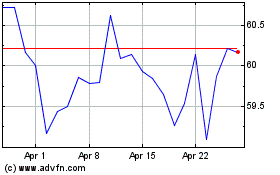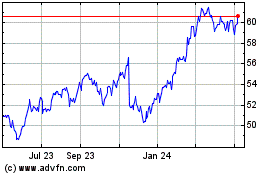By Sharon Terlep
The biggest and most beleaguered names in beauty are trying to
stage a comeback, but first they must shed their reputation as
dated drugstore staples.
Brands like CoverGirl, Maybelline and Revlon for decades
dominated beauty aisles in drugstores and supermarkets, winning
women over with vibrant colors and affordable prices. But they have
lost ground to smaller rivals, from online-only brands to
higher-end names like MAC and Urban Decay to lines popularized by
the rise of specialty retailers like Sephora. Even drugstores have
cut back on beauty mainstays in favor of trendier names.
More recently, the big brands have been slow to catch on as
social media transformed the way beauty products were discovered,
especially by younger shoppers who often hear about new products
from YouTube tutorials and Instagram posts by "influencers," or
social-media stars. Niche brands have been far quicker to market on
social media.
The upheaval has driven losses, prompted the ouster of
executives and spurred acquisitions at companies such as Revlon
Inc., L'Oréal SA and, the biggest player, Coty Inc.
"It's not a matter of big and small. It's a matter of how you
connect with the consumer," Coty CEO Camillo Pane said in an
interview. "And our brands did not necessarily connect with
consumers in the past."
To resuscitate ailing brands, Coty and its rivals are churning
out trendier options such as facial highlighter and metallic
lipcolor, recruiting more relatable spokespeople, and speeding how
quickly new products get to market.
Coty has been struggling since acquiring the bulk of Procter
& Gamble Co.'s beauty business, including CoverGirl, in 2016
for $11.6 billion. The brands, the company said, turned out to be
sicker and more difficult to integrate than the company
anticipated.
Take CoverGirl, which saw its share of the $16 billion U.S.
color cosmetics market fall to 6.9% in 2016, from 9.2% in 2011,
according to Euromonitor.
Now the 60-year-old brand is getting dozens of new products and
made-over store displays. Instead of using only supermodels -- a
mainstay of yesteryear -- its new marketing campaigns feature
spokeswomen like a 69-year-old grandmother and a fitness trainer
with more than 2 million Instagram followers.
Mr. Pane and other top executives have been lobbying retailers
like CVS Health Corp. and Walmart Inc. to give back some of the
shelf space CoverGirl lost over the years as its popularity
flagged.
That can be a hard sell. While CVS says beauty products are
important to sales, its focus isn't necessarily on big-name brands.
At an event last year, executives bragged about attracting niche
beauty makers and launching their own private-label products in
response to demand for nontraditional brands.
The chain is installing new, higher-end beauty sections in
stores, stocked with smaller brands and exclusive offerings, in an
effort to better compete with beauty retailers like Sephora and
Ulta.
"Coty is under a lot of pressure to get this right," said
Jefferies analyst Stephanie Wissink. "CoverGirl might become the
proxy for the success story for a brand that's under attack. Or
they might become the case study for why a makeover in packaging
and marketing isn't enough to rebuild."
Shannon Curtin, head of Coty's consumer beauty unit, said
CoverGirl's rebirth goes deeper.
Development time for new products is down to as little as six
months instead of as much as two years, and one-quarter of the
brand's lineup will be entirely new products, Ms. Curtin said.
"We didn't have items people were buying -- primers, brows,
corrector kits," she said. "And now we do."
Olivia Cecchi, a recent college graduate who was browsing the
cosmetics section of a New Jersey drugstore recently, said she was
willing to spend on makeup but only at a store like Sephora, which
allows customers to sample the products. "I'd only buy something
here if I really needed something and didn't want to spend a lot of
money," she said, passing by CoverGirl and Revlon displays to look
at Wet n Wild, which offers 99-cent lipsticks.
CoverGirl's biggest rivals are also struggling to woo such
shoppers. The five biggest mass-market beauty brands lost a
combined 5 percentage points of market share between 2011 and 2016,
while higher-end and smaller mass-market brands picked up share,
according to Euromonitor.
Slow sales of Maybelline in the U.S. is dogging L'Oréal, whose
luxury and professional brands are still growing. In a November
call with analysts, L'Oréal CEO Jean-Paul Agon described the
mass-beauty segment as "pretty weak" and said the company hopes to
bolster sales in part by leveraging the newer NYX brand, which it
acquired as a startup in 2014 for $500 million.
Last month, Revlon said its CEO, Fabian Garcia, would leave the
New York company, whose shares are down 35% from a year ago amid
financial losses, declining market share and concerns from
investors that the company can't pay its debt.
"The internet has become the true equalizer," said Tarang Amin,
CEO of e.l.f. Beauty Inc. The brand started by selling online in
2004 and now generates most sales from Walmart and other
stores.
In addition to the benefits of online marketing and selling, Mr.
Amin said the New York company is benefiting from ultrafast
development times and consumers who are more willing to shop across
segments. "They are just as likely to have a Chanel item as an
e.l.f item."
Write to Sharon Terlep at sharon.terlep@wsj.com
(END) Dow Jones Newswires
February 05, 2018 05:44 ET (10:44 GMT)
Copyright (c) 2018 Dow Jones & Company, Inc.
Walmart (NYSE:WMT)
Historical Stock Chart
From Mar 2024 to Apr 2024

Walmart (NYSE:WMT)
Historical Stock Chart
From Apr 2023 to Apr 2024
